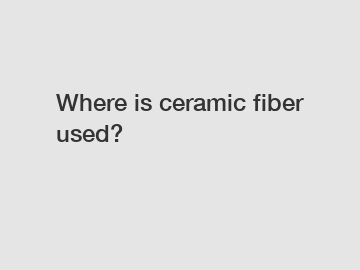Where is ceramic fiber used?
Where is Ceramic Fiber Used?
Ceramic fiber is a versatile material that finds a wide range of applications across different industries. From insulation in high-temperature environments to thermal protection in various equipment, this fibrous material has proven its worth. But where exactly is ceramic fiber used? Let's explore its applications in detail.
1. Industrial Insulation:

Ceramic fiber is extensively used for insulation purposes in industries. Its excellent thermal properties make it ideal for applications that involve high temperatures. Whether it's lining furnaces, kilns, or boilers, ceramic fiber offers exceptional insulation, minimizing heat loss and saving energy. It also resists thermal shock, ensuring long-lasting performance in demanding industrial environments.
2. Power Plants:
Power generation plants are another significant area where ceramic fiber finds extensive application. From power boilers to exhaust systems, this material effectively handles the high temperatures associated with power generation. Ceramic fiber blankets are commonly used in power plants due to their superior insulation properties and ability to withstand thermal cycling.
3. Automotive and Aerospace:
In the automotive and aerospace industries, ceramic fiber is utilized due to its lightweight and strong insulation properties. It plays a crucial role in reducing heat transfer within engines and exhaust systems, strengthening overall performance. The material's ability to function at high temperatures contributes to the efficient operation of these systems.
4. Foundries:
Foundries are known for their extreme heat and harsh conditions. Ceramic fiber helps in containing heat, protecting both personnel and equipment in this environment. It is commonly used for lining ladles, furnaces, and molds. Ceramic fiber products, such as boards and modules, are also used to construct combustion chambers and heating areas in foundries.
5. Petrochemical and Refining:
Ceramic fiber's resistance to thermal shock and chemical corrosion makes it an excellent choice for petrochemical and refining applications. It is used to insulate equipment like tanks, reactors, and pipes, where high temperatures and corrosive chemicals are present. Ceramic fiber also plays a crucial role in reducing heat loss, providing energy efficiency in these industries.
6. Glass Manufacturing:
Glass manufacturing processes involve high temperatures and continuous exposure to heat. Ceramic fiber helps maintain the required temperature profile in glass melting furnaces. Its insulation properties ensure minimal heat loss, thus reducing energy consumption. Ceramic fiber is also used to manufacture glass fiber, which is widely used in various industries, including construction and automotive.
7. Space Exploration:
Ceramic fiber's ability to withstand high temperatures and extreme conditions have made it indispensable in space exploration. It is extensively used in the construction of spacecraft and space shuttles. From rocket nozzles to thermal protection systems, ceramic fiber ensures the safety and successful functioning of various space missions.
Conclusion:
The wide array of applications for ceramic fiber demonstrates its remarkable versatility and adaptability. Whether in industrial settings like power plants and foundries or in aerospace and automotive industries, ceramic fiber plays a vital role in insulation and thermal protection. Its ability to withstand high temperatures, resist thermal shocks and chemical corrosion, along with its lightweight properties, make it an ideal choice for numerous applications. As technology advances and industries continue to push boundaries, ceramic fiber will undoubtedly remain a critical material for ensuring safety, efficiency, and reliable performance.
For more refractory mortar, refractory mortar, Fireclay Brick Recipeinformation, please contact us. We will provide professional answers.
263
0
0

Comments
All Comments (0)